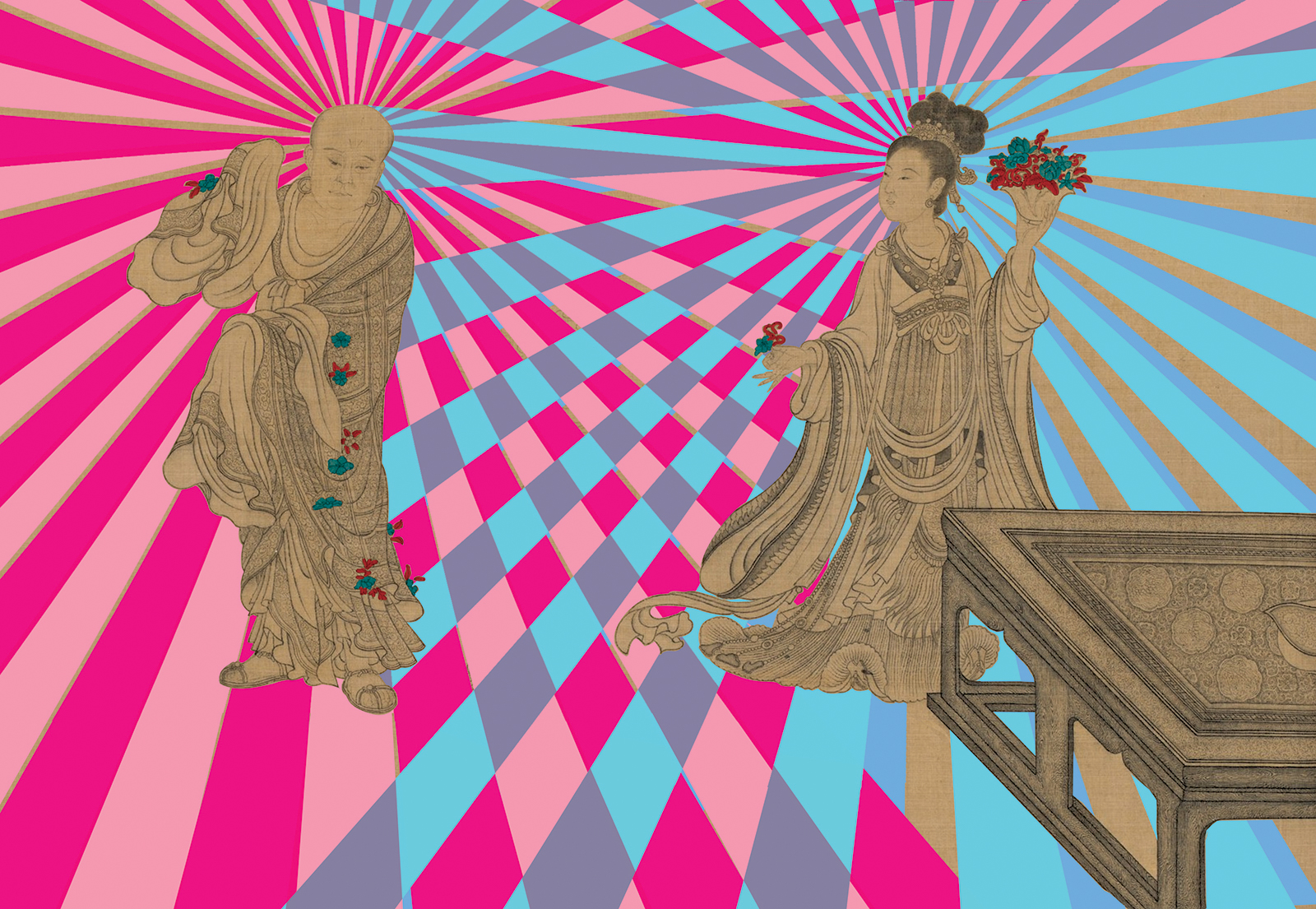
Image adapted from Wang Zhenpeng (Chinese, active ca. 1275–1330); Vimalakirti and the Doctrine of Nonduality; China; 1308; handscroll, ink on silk; The Metropolitan Museum of Art; Purchase, The Dillon Fund Gift, 1980; 1980.276.

Image adapted from Wang Zhenpeng (Chinese, active ca. 1275–1330); Vimalakirti and the Doctrine of Nonduality; China; 1308; handscroll, ink on silk; The Metropolitan Museum of Art; Purchase, The Dillon Fund Gift, 1980; 1980.276.
Peter Sellars: The spark was reading Robert Thurman’s incredible translation of the Vimalakirti Sutra, first published in 1976. Reading it you feel a new generation of Buddhism in America. The volume is translated into lucid, colloquial, direct American speech, has three glossaries in the back, and is super radical and useful and has a sharp sense of humor.
There’s also an incredible sense of beauty and amazement and wonder. You just say, “Oh right, these are not the old school of sutra translations. This is the beginning of Buddhism having another type of presence in the West and not just visiting but taking up residence here.” You can feel it in this volume as you hold it—the announced intention that things will be different from now on.
One of the reasons I’ve been obsessed with Vimalakirti is that it has shocking shifts of tone, unexpected bursts of humor, reversals of received wisdom, and a stunning spectacle of astonishing things happening. It has really sharp dialogue, and of course my feeling was that this was meant to be staged.
It was the beginning of the Mahayana series of sutras, which were getting Buddhism out of the monasteries and back into public life. It was designed to be performed in the marketplace for an illiterate population who needed access to Buddhist texts but could not stop their lives and go into a library. So it was meant to have a wide popular appeal and have images, which were memorable and resonated.
The goddess chapter of the sutra is astonishing, because it is—as far as I can tell—the first statement of gender equality in world literature. It’s from the first century, and what’s so beautiful is that the sutra doesn’t announce it but rather demonstrates it, which is why I think it was meant to be performed.
Sariputra, Buddha’s lead disciple, encounters the goddess in Vimalakirti’s house. They have a philosophical discussion, and she wins every point. After a while he says, “You’re quite intelligent for a woman.”
The goddess laughs and exchanges bodies with Sariputra. Suddenly he finds himself in her body, and she is occupying his body. When you think about it, this is so mind-blowing. Meanwhile it’s a delicious assignment for two brilliant actors and a cue for a virtuosic and unforgettable performance.
To lay out the equality of women and the fluidity of gender in the first century in this visionary sutra challenges materialistic and rigid conceptions of gender. The sutra is so radical and at the same time so entertaining.
For me it’s very important that there is a documentary element. I think it’s no accident that half the films people are looking at these days are documentaries. People have a real hunger for something that can be demonstrated and has a ring of truth, so for me it’s important to be very scrupulous with the text. In the performance we project the text behind the performers—huge on the wall—so it has the power of the Lincoln Memorial or something grand carved into the wall.
I’ve been thinking about this sutra for twenty-five years, and when we started rehearsing this chapter a few months ago I didn’t anticipate what would happen. I just knew we needed two extraordinary artists. One of them is Michael Schumacher, the spectacular improvisatory dancer, and the other is the extraordinary Ganavya Doraiswamy who comes out of a South Indian vocal tradition.
Michael and Ganavya are truly exploring the material. Their assignment is to work through a sentence until they begin to understand it. That’s a genuine meditation and a shared meditation. They meditate in song and in movement, and gradually a text starts to assume dimensionality. You realize that each one of these texts has worlds inside it.
It’s a breakthrough sutra because it says a lay person is as holy and evolved as a buddha or monk, and the life choice to be a monk is not superior. The early chapters of the sutra are about socially engaged practice, as Vimalakirti describes his time with prostitutes, drug dealers, and a whole range of things that are on the no-go list for young monks.
In fact, Vimalakirti is there where anybody needs him. He’s very much in this world and doing the work of Buddha in the world. That’s a very powerful image. In the first century this kind of radicalism was also occurring in the early period of Christianity. The movement is away from the centers of the presumed power of organized religion and into direct street action.
I have a feeling that working on the Vimalakirti Sutra will be a lifelong project. We will treat different chapters in different episodes as their own experiences. I can imagine gradually accumulating a series of performances that start to make a pathway through the sutra. I’m never in a rush. I just say, “Let’s work on this, and when we feel that it’s there then we’ll offer it to the public.” I love performing at the Rubin, and I imagine performing this in museums and in places that already have a context.
I think most people are truly looking for some ancient truths that you can hold on to. As the world gets more outrageous and out of control and violence and injustice swirl around us, what is the refuge? I think Buddhism was created as a place of refuge.
I think people are searching for genuine refuge now. There are sixty thousand people coming from Honduras and Guatemala on the United States–Mexico border right now. What is the meaning of refuge at this moment? The hunger and need is there. So I don’t really think of this as show business; I think of it as trying to touch something that we’re all searching for. That’s the hope.
The fluid nature of impermanence is that this will change. Winter is not going to last forever. The ice will melt. One of the most incredible Buddhist images is ice and water as the same thing—the surrounding conditions are what changes. I think of impermanence in the sense of the wisdom that it will not be winter forever, and it won’t be spring forever either. We move through all of these things.
It’s that every being has a spiritual life, and in what ways can we acknowledge and deepen that. What I’m essentially trying to do is create church outside of church. I’m trying to get outside of the structures of organized religion and treat these texts and stories as teaching stories.
Inspiration comes from the heartbreaks, disappointments, and cruelties of the world. When you see stuff that needs to be addressed and you see things that are not correct, you realize we’ve got to go back in and go deeper. Our work has to be better, more amazing, more powerful, and more generous.

Peter Sellars is an American theater director noted for his groundbreaking, transformative stagings of classical and contemporary operas and plays. He has gained international recognition for his work and is also a professor at UCLA, where he teaches art as social and moral action.

Howard Kaplan is an editor and writer who helped found Spiral magazine in 2017. He currently works at the Smithsonian and divides his time between Washington, DC, and New York City.
Get the latest news and stories from the Rubin, plus occasional information on how to support our work.